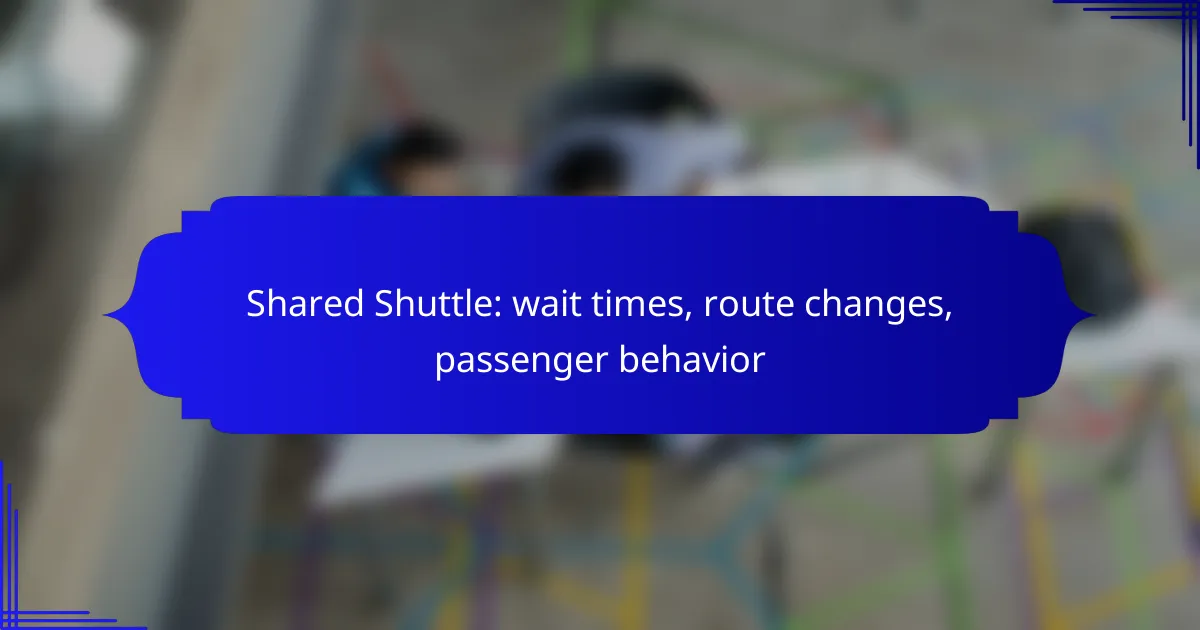Shared shuttles offer a convenient transportation option, with average wait times in London ranging from 10 to 30 minutes, influenced by factors like demand and time of day. Route changes can impact travel times and passenger loads, making it essential for riders to stay informed for better journey planning. Additionally, passenger behavior is shaped by service quality and pricing, providing valuable insights for operators to enhance their offerings.
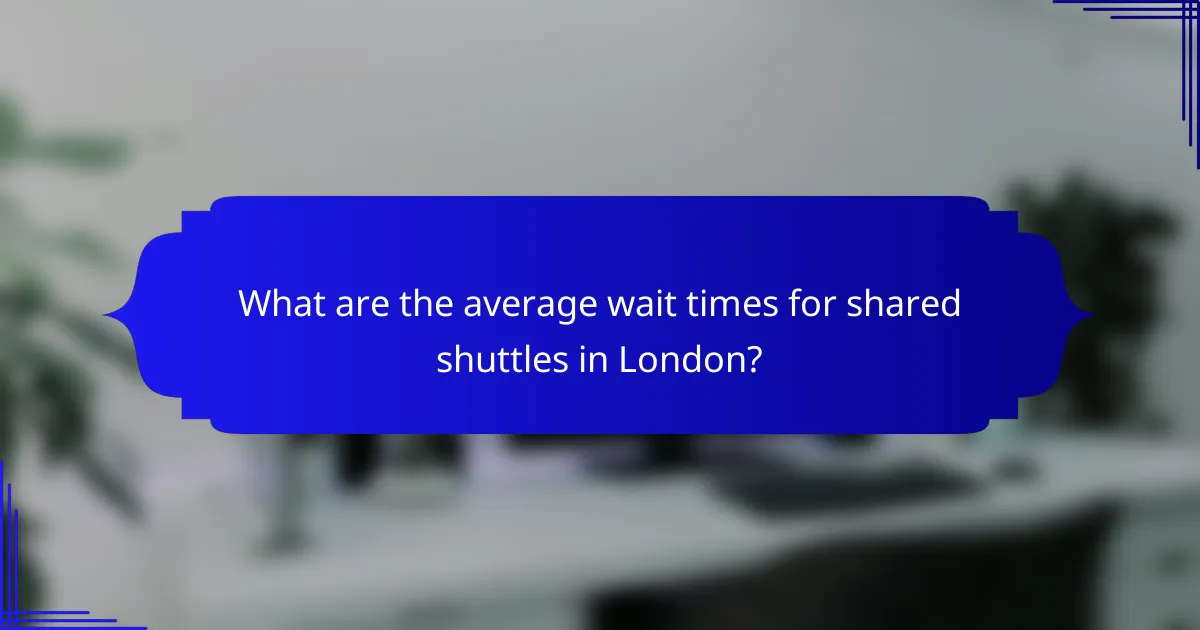
What are the average wait times for shared shuttles in London?
The average wait times for shared shuttles in London typically range from 10 to 30 minutes, depending on various factors such as the time of day and demand. Understanding these wait times can help passengers plan their journeys more effectively.
Typical wait times during peak hours
During peak hours, which generally include weekday mornings and late afternoons, wait times for shared shuttles can increase significantly. Passengers may experience wait times of 20 to 40 minutes due to higher demand and traffic congestion. Booking in advance is advisable to minimize delays.
Average wait times during off-peak hours
In contrast, off-peak hours, such as mid-mornings and early afternoons, usually see shorter wait times. Passengers can expect wait times of around 10 to 20 minutes during these periods. This is an ideal time for travelers looking to avoid the rush and secure quicker service.
Factors affecting wait times
Several factors can influence wait times for shared shuttles in London. These include traffic conditions, the number of passengers booking at the same time, and the efficiency of shuttle dispatch systems. Additionally, weather conditions can also play a role, as inclement weather may slow down travel times.
Passengers should consider these factors when planning their trips. Checking real-time updates through shuttle service apps can provide insights into current wait times and help adjust travel plans accordingly.
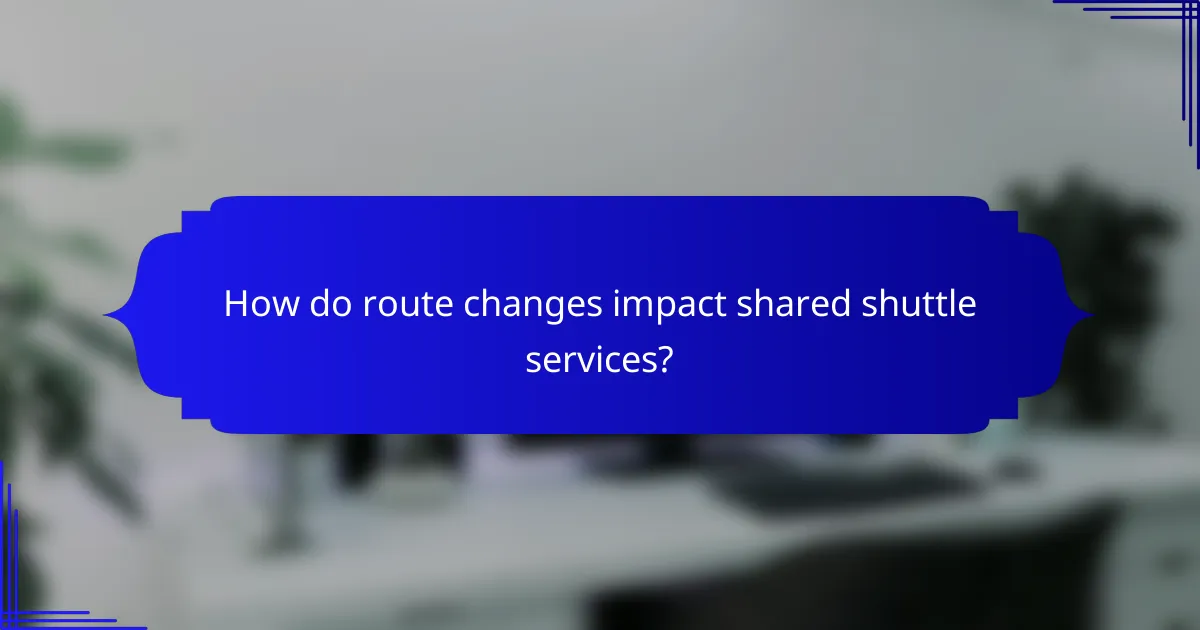
How do route changes impact shared shuttle services?
Route changes can significantly affect shared shuttle services by altering travel times, passenger loads, and overall efficiency. These adjustments may be necessary due to various factors, and understanding their implications helps passengers plan better.
Common reasons for route changes
Route changes in shared shuttle services often occur due to construction, traffic patterns, or changes in demand. For instance, if a new shopping center opens, shuttles may adjust their routes to accommodate increased passenger traffic. Additionally, seasonal variations can lead to temporary route modifications to optimize service.
Regulatory changes can also prompt route adjustments. Local governments may impose new regulations that require shuttles to avoid certain areas or prioritize specific routes, impacting the overall service structure.
Effects on passenger schedules
When routes change, passengers may experience longer or shorter wait times, which can disrupt their schedules. For example, if a shuttle route is modified to include additional stops, passengers might face extended travel times. Conversely, streamlining routes can lead to quicker service.
Passengers should be aware that changes can also affect the frequency of shuttles. If a route becomes less popular, shuttles may run less often, requiring passengers to adjust their travel plans accordingly.
How to stay informed about route changes
To stay updated on route changes, passengers should regularly check the shuttle service’s official website or mobile app, where announcements are typically posted. Many services also provide real-time updates via notifications, which can be particularly useful for frequent travelers.
Additionally, subscribing to email alerts or following social media accounts of the shuttle service can help passengers receive timely information about any upcoming changes. Engaging with customer service can also provide clarity on specific concerns regarding route adjustments.
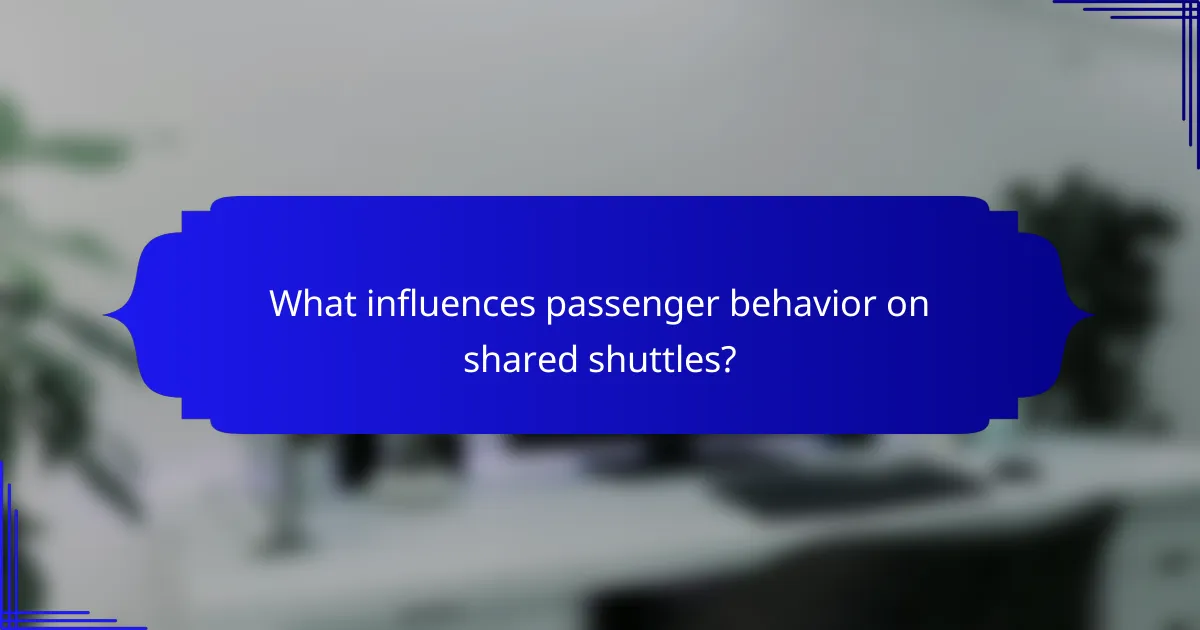
What influences passenger behavior on shared shuttles?
Passenger behavior on shared shuttles is influenced by factors such as service quality, pricing, and personal preferences. Understanding these influences can help shuttle operators tailor their services to meet customer needs effectively.
Passenger preferences for shuttle services
Passengers often prioritize convenience, comfort, and reliability when choosing shared shuttle services. Factors like the frequency of departures, travel time, and the availability of amenities such as Wi-Fi or charging ports can significantly impact their decision-making.
For example, a shuttle that offers more frequent departures and shorter wait times is likely to attract more passengers. Additionally, the ease of booking and payment options can also play a crucial role in shaping passenger preferences.
Impact of pricing on passenger choices
Pricing is a critical factor influencing passenger choices for shared shuttles. Competitive pricing can attract more customers, while higher prices may deter potential riders. Many passengers are willing to pay a premium for added comfort or convenience, but they also seek value for their money.
Operators should consider offering tiered pricing or discounts for early bookings to appeal to budget-conscious travelers. Additionally, transparent pricing structures help build trust and encourage repeat usage.
Role of customer reviews in decision-making
Customer reviews significantly impact decision-making for potential passengers. Positive reviews can enhance a shuttle service’s reputation, while negative feedback can deter new customers. Passengers often rely on online platforms to gauge the quality of service before making a choice.
To leverage this, shuttle operators should actively encourage satisfied customers to leave reviews and respond promptly to any negative feedback. Building a strong online presence through reviews can enhance credibility and attract more riders.

How to choose the best shared shuttle service in London?
To choose the best shared shuttle service in London, consider factors such as reliability, cost, and customer reviews. Evaluating these aspects will help you find a service that meets your needs while ensuring a smooth travel experience.
Criteria for selecting a shuttle service
When selecting a shared shuttle service, prioritize reliability and punctuality. Look for providers with a strong track record of on-time departures and arrivals, as delays can significantly impact your travel plans.
Cost is another crucial factor; compare prices among different services to find a balance between affordability and quality. Additionally, consider the shuttle’s capacity and comfort level, especially for longer journeys.
Customer reviews can provide valuable insights into the overall experience. Check online platforms for feedback on cleanliness, driver professionalism, and ease of booking.
Comparative analysis of popular shuttle providers
Several shuttle providers operate in London, each with its unique offerings. For instance, companies like EasyBus and National Express are known for their extensive routes and competitive pricing, making them popular choices among travelers.
On the other hand, providers such as SuperShuttle focus on premium services, offering more comfort and personalized experiences, albeit at a higher cost. It’s essential to weigh these options based on your budget and travel preferences.
Additionally, consider the frequency of departures. Some services may offer more regular shuttles, reducing wait times and making your journey more convenient. Always check the latest schedules and availability before booking.

What are the safety measures in place for shared shuttles?
Shared shuttles implement various safety measures to protect passengers and ensure a secure travel experience. These measures typically include health protocols, driver training, and vehicle maintenance standards that comply with local regulations.
Health and safety protocols
Health and safety protocols for shared shuttles often encompass regular sanitization of vehicles, mandatory mask-wearing, and social distancing measures when possible. Passengers may be required to undergo temperature checks before boarding, especially during health crises.
Additionally, many services provide hand sanitizers inside the shuttle and encourage passengers to maintain personal hygiene. These practices help mitigate the risk of spreading illnesses among travelers.
Driver training and qualifications
Drivers of shared shuttles undergo extensive training to ensure they meet safety standards and possess the necessary qualifications. This training typically includes defensive driving techniques, emergency response procedures, and customer service skills.
In many regions, drivers must also pass background checks and obtain specific licenses or certifications. This ensures that they are not only skilled in operating the vehicle but also capable of handling various passenger needs and safety concerns effectively.
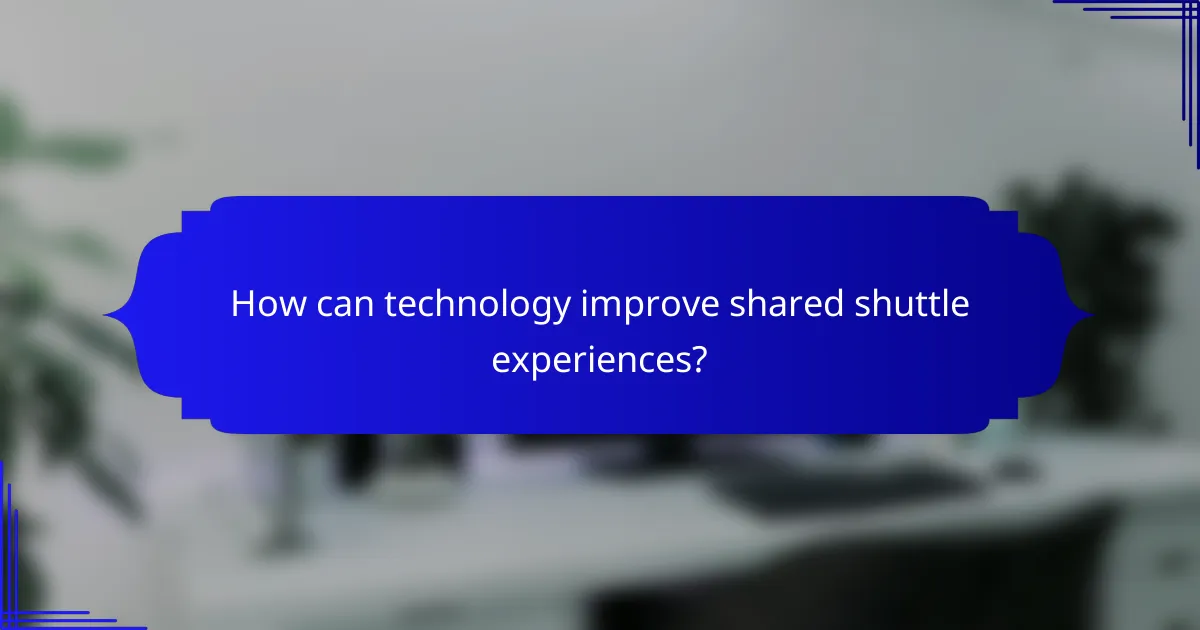
How can technology improve shared shuttle experiences?
Technology enhances shared shuttle experiences by providing real-time information and convenient payment methods. These advancements help passengers make informed decisions, reduce wait times, and streamline the overall travel process.
Mobile apps for real-time tracking
Mobile apps enable passengers to track their shared shuttle in real-time, offering updates on arrival times and potential delays. This feature allows users to plan their journeys more effectively, reducing uncertainty and wait times at pickup points.
Many shuttle services now integrate GPS technology into their apps, which can display the shuttle’s current location on a map. Passengers can receive notifications about changes in schedules or routes, ensuring they stay informed about their travel options.
Contactless payment options
Contactless payment options simplify the transaction process for shared shuttle services, allowing passengers to pay quickly and securely without cash. This method is particularly beneficial in urban areas where speed and convenience are essential.
Many shuttle operators now accept mobile wallets or contactless credit cards, which can expedite boarding times. Passengers should check if their preferred shuttle service supports these payment methods to avoid delays and enhance their travel experience.

What are the emerging trends in shared shuttle services?
Emerging trends in shared shuttle services include a focus on sustainability, technology integration, and evolving passenger expectations. These trends are reshaping how shuttles operate, with an emphasis on eco-friendly options and improved customer experiences.
Growth of eco-friendly shuttle options
The demand for eco-friendly shuttle services is rising as passengers become more environmentally conscious. Many shuttle operators are now incorporating electric and hybrid vehicles into their fleets to reduce carbon emissions and promote sustainability.
These eco-friendly shuttles not only help the environment but can also lead to cost savings in fuel and maintenance. For instance, electric vehicles typically have lower operating costs compared to traditional gasoline-powered shuttles.
Passengers can expect to see more charging stations at shuttle stops and increased availability of green options in urban areas. When choosing a shuttle service, consider looking for operators that prioritize sustainability to align with your eco-friendly values.
